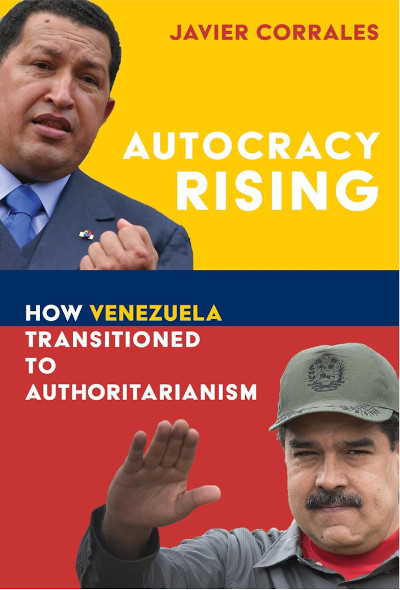En la imagen
Cover of ‘Autocracy rising: How Venezuela transitioned to authoritarianism’, by Javier Corrales (Washington: Brookings Institution, 2023) 256 pages
In a world with democracies in retreat and autocracies on the rise, it is advisable to analyze the process of democratic deterioration in order to be aware of the elements that some leaders use to perpetuate themselves in power, transitioning towards semi-authoritarianism and, progressively, towards full authoritarianism. Corrales, professor of Political Science at Amherst College, in Massachusetts, takes his country of origin, Venezuela, as a clear example of this slide towards dictatorship.
Corrales already dealt with Chavismo in 'Dragon in the Tropics: Venezuela and the Legacy of Hugo Chavez' (2015), written with Michael Penfold. He already wrote there about the authoritarian tics of the Caribbean leader, although then his purpose was to document Venezuela's economic and social collapse during the thirteen years of Chavez's government.
Here the author looks specifically at the destruction of Venezuela's democracy and proposes it as paradigmatic process. He compares Venezuela to other Latin American countries that have also experienced democratic declines. He includes countries like Nicaragua and Ecuador, which during the same period of time were ruled by the so called 21st Century Socialism, but Colombia as well, that at the time had a right-wing government. The book is a study about the democratic evolution in these four cases in the last fifteen years.
In his academic study, Corrales uses the concepts of democratic backsliding, asymmetrical party system fragmentation, institutional capturing, institutional reservoirs, and function fusion as an explanation of the gradual collapse of the democratic freedoms. In the specific case of Venezuela, the country fully transitioned into a full-fledged autocracy in the 2010's with the death of Hugo Chavez, the undemocratic appointment of Nicolas Maduro in 2013, and the violent crackdown of the opposition afterwards. However, it is important to highlight that Chavismo, according to the author's analysis, was from the beginning a form of democratic backsliding, considering that under Chavez all the political mechanisms were put in place for him to stay in power. With a collapsing economy and tremendous unpopularity, Maduro's only chance of following his predecessor and surviving in office was to deepen ‘autocratization’ with the support of other external ‘autocratizing’ actors such as Fidel Castro.
Corrales applies his analysis to three other Latin American countries – Colombia, Ecuador, and Nicaragua– hat experienced different levels of autocracy. The author specifically focuses on these countries’ institutional fragility and how democratic backsliding advanced in symphony with the increasing levels of authoritarian rule. However, it is important to note that none of these countries have reached such a high level of autocratic rule as Venezuela has in the past decade and a half. Corrales sees Venezuela as an extreme exponent, closely followed by Nicaragua. Like Chavez, Daniel Orteg's voters are both low-income and low-educated people who, due to their lack of education, have fallen for their leaders lies. The voters have voted democratically for tyrants seeking to facilitate their country's transition to full autocratic rule and maintain supreme rule. Furthermore, like in Venezuela, Nicaragua, with the control of the judiciary and the executive branches, created the perfect conditions for the Sandinista leader to become the supreme ruler of the Central American nation.
Contemporary to Chavez in Venezuela, according to Corrales' analysis, presidents Rafael Correa in Ecuador and Alvaro Uribe in Colombia engaged in practicing deficient democratic policies. However, contrary to Maduro, their successors did not proceed any further in expanding autocratic practices. Instead, Lenin Moreno and Iván Duque opted to liberalize the regime altogether in their respective nations. The first five years of the presidency of Chavez, Ortega, Correa, and Uribe had a semi-authoritarian profile, but only Chavez and Maduro in Venezuela and Ortega in Nicaragua transitioned to whole authoritarianism afterwards.
Ever since this transition began taking place, poverty in Venezuela skyrocketed, and children were pulled away from their education due to a lack of funds, food, transportation, strikes, and power outages. Furthermore, crime rates also increased as a direct effect of the narco-politics inflicted by Maduro. The author utilizes figures such as tables and graphs to show this unfortunate trend Venezuela is currently experiencing numerically.
Throughout his analysis, the author repeatedly insists on and expresses the significant causes for the transition from democracy to autocracy. These reasons englobe the institutional fragility the country is undergoing as well as leftist-populist movements, uprisings, and threats.
In summary, Corrales' analysis underscores the importance of understanding the complex interplay of factors contributing to a country’s transition from democracy to autocracy. Institutional fragility, coupled with the rise of populist movements, can create a good ground for autocratic practices. Venezuela's case serves as a reminder of the dangers of this transition, with severe consequences for human rights, governance, and international relations.

